USS George H.W. Bush CVN77
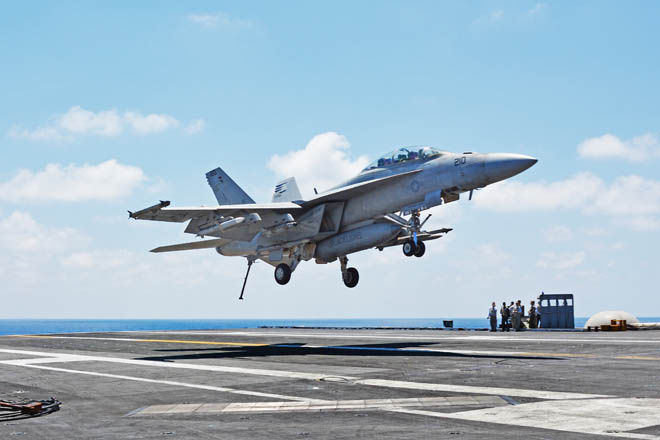
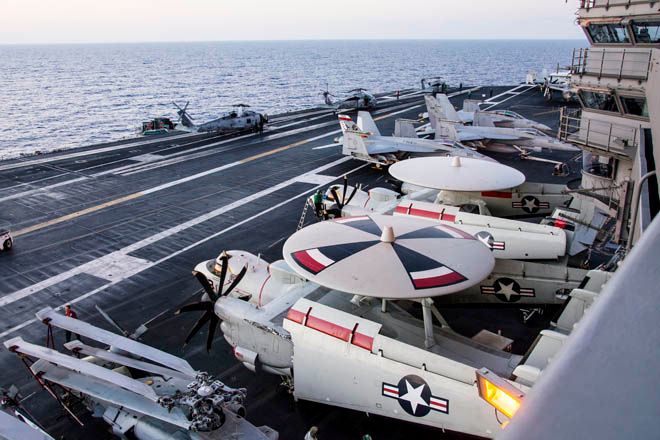
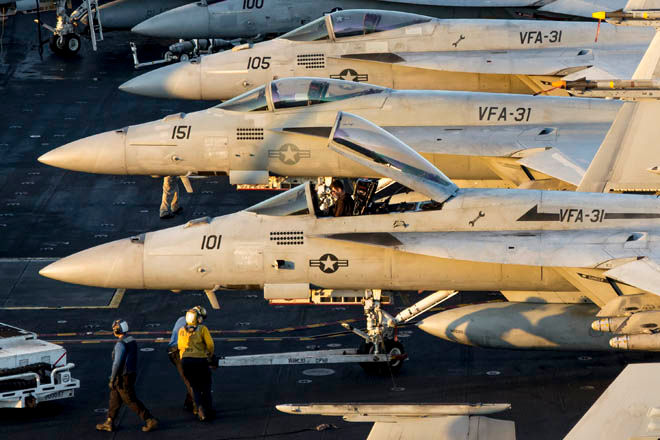
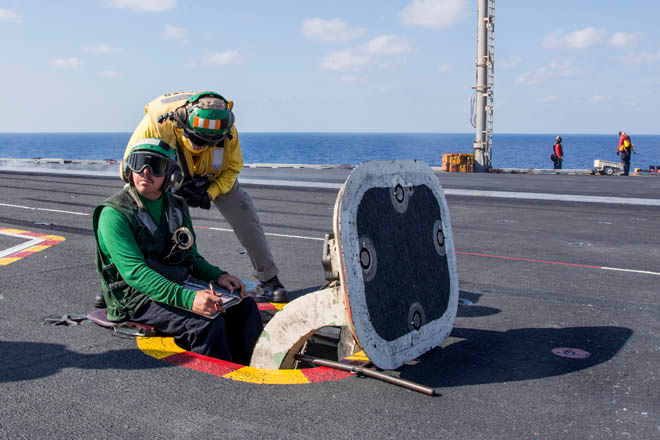
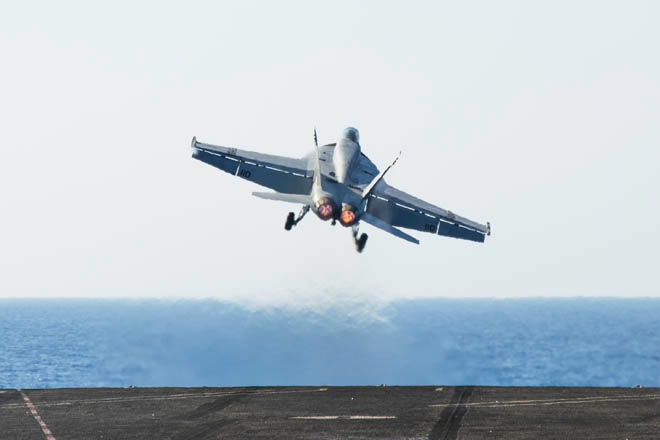



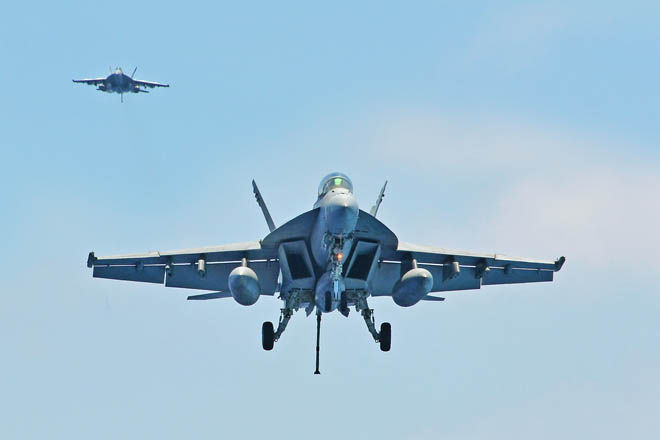
Defenceline.gr at USS George Bush: 48 hours in operations against ISIS
Reportage - Photos: Vangelis Antonakis
The meeting was made early in the morning at the gate of the American sector of Souda Bay AFB in Chania, Crete. The day began with clear skies and ideal temperature for the season.
After arriving at the airport, we were welcomed by a member of the VRC-40 Rawhides, the detachment of the C-2 Greyhound aircrafts that operated from the USS George HW Bush CVN77 aircraft carrier which would be our home for the next two days. Having been informed about flight conditions of such an airplane and the dangers of landing our aircraft on the carrier, we were shown the rescue means that we would have to wear during our 2-hour trip from Souda somewhere in the eastern Mediterranean where the ship were and operating.
For the next two hours, we would have to wear our life jacket, helmet with safety glasses, and be tightly attached to the four-point belt, essentially stuck in the opposite of the air-mounted seat. With brief procedures we went to the airport apron where the aircraft had already started up its engines and after we got in and before we got stuck,the ramp in the back was hermetically closed behind us with the few rays of light now entering the cabin exclusively from the two small windows that are located on either side of the fuselage next to which we took over and took position, following the suggestion of persons with relevant experience in flights with such aircraft. The ideal side is the left side of the aircraft as we would have the opportunity to admire the aircraft carrier from above if we were to be in a holding pattern while approaching the aircraft carrier.
Taxing took place at a speed much higher than we are used to in civil aviation flights, with the F-16 Block 52+ of the Hellenic Air Force taxing from the opposite side of the runway. Line up and immediate take-off from Souda runway 30, acceleration, high climbing rate, gear up and closed right turn. Soon we saw Chania on the left side of the plane for a while, as the continuing change of course soon brought us over the NAMFI , heading east to Heraklion. I ask to go to the cockpit and the loadmaster leads me through an extremely short and narrow corridor to the cockpit where I replace the helmet with headphones through which I can talk to the pilots. At that time from below and while we were flying at 10,000 feet I see the city of Heraklion.
I am excited to inform the pilot that I live in Heraklion. It is my pleasure to say that it is an excellent opportunity to see from above and turns the plane almost 90 degrees on its longitudinal axis. I now see the port of Heraklion from 10,000 feet vertically from the right window of the cockpit. After a few seconds, he returns the aircraft to its original flight path and continues over Agios Nikolaos and then on a south-eastern route towards the end of Crete. Where the land is replaced by the sea and now we fly over the Mediterranean towards USS GHW Bush.
After almost two hours we begin to reduce height and the straight path begins to be replaced by open and then very closed turns at high speed. I feel like I'm fighting with a fighter as I struggle to get rid of G that weighs the body and make it harder for our moves. Soon I can see the airplanes below our C-2 Greyhound in the catapults ready to launch. After 3 turns and while we are constantly dropping, we hear the slogan from the crew that we are ready for a landing on the airplane "Here we go, here we go, here we go" and after a few seconds we feel the snap hook grabbing the second cable and We have stuck in our seats by the sudden drop in airplane speed. The Greyhound folds its wings twisting to take a parking place on the deck and we see the familiar silhouettes of the F / A-18 Hornet from the small window. Our two-day cruise in the Mediterranean has just begun!
The USS George HW Bush US Navy is the latest Nimitz class and the newest, until the coming USS Ford in the coming years, with its entrance into service in 2009. The ship was built at the Newport News yards and its base is Virginia's Norfolk Naval Base on the east coast of the US. His name has been received by the 41st President of the United States of America, who in 2WW flew into the Navy with a TBM-1 Avenger and took part in the battles in the Pacific.
The vessel is 332.8m long and 76.8m wide and can achieve speeds of up to 30 knots. It has four engines powered by two nuclear reactors. It has 3,200 crew members and including 2,500 of the airplane combat wings in total carrying more than 6,000 souls.
The flies and the aircraft
At the moment, the Carrier Strike Group 2 CSG-2 is the USS GHW Bush CVN77 aircraft carrier, Carrier Air Wing 8 Aircraft Fighter Wing consisting of the following Miles:
1. VFA-213 Fighting Black Lions with F / A-18 Super Hornet
2. VFA-31 Tomcatters with F / A-18 Super Hornet
3. VFA-87 Golden Warriors with F / A-18 Super Hornet
4. VFA-37 Ragin Bulls with F / A-18 Legacy Hornet
5. Electronic Attack Squadron (VAQ) 131 Lancers with EA-18 Growler
6. Early Warning Squadron (VAW) 124 Bear Aces with E-2D Hawkeye
7. Helicopter Mine Countermeasure Squadron (HSM) 70 Spartans
8. Helicopter Sea Combat Squadron (HSC) 9 Tridents
9. Excerpt of VRC 40 "Rawhides with two C-2 Greyhounds
As well as the DESRON 22 group with the following ships:
1. USS Laboon (DDG 58)
2. USS Truxtun (DDG 103)
3. USS Philippine Sea (CG 58)
4. USS Hue City (CG 66).
All of this is in itself a force capable of carrying out a wide range of operations from sea and air with absolute flexibility of movement and the ability to grow anywhere on the planet.
The latest USS Bush aircraft tour began on January 21, 2017 when set sailed from the Norfolk Naval Station and after entering the Mediterranean he headed for the Souda Bay Naval Base for a few days. Then sailed and started to work against the forces of the Islamic State in Syria. Soon, however, returned to Souda Bay for some unexpected but necessary maintenance and repairs, which after completing the ship headed to the Fifth Fleet in the Persian Gulf, from where he had the opportunity to conduct operations against ISIL in northern Iraq, in the area of Mosul. Early in June, after crossing the Suez Canal, entered for the second time in the area of responsibility of the 6th Fleet in the Mediterranean where he immediately took action over Syria.
The importance of the American presence in the area was reported by the captain of the ship Capt. Will Pennington, with more than 3,500 flight hours with F-14 and F / A-18 aircraft. "It is very important for the US Navy to honor this alliance with its participant. As you will know, however, we are not here just for this reason. With our presence here, we renew and strengthen cooperation relations with many countries in the region. Since the early 1990s, much of our business has been focused on the Middle East, which remains very important. But with the increase in Russia's presence in the Mediterranean, it is important that we also spend some time here. "
Activation in the Mediterranean involves several differences in relation to the Persian Gulf. "The advantage of operating here is that we have better weather conditions than the Persian Gulf. For example, we do not have sandstorms that greatly affect the electronic equipment of aircraft and their sensors. The other advantage is that it is larger in size and there is no congestion in the movement of the boats and as a result we have more flexibility of movement. On the other hand, the heavy weight of businesses in recent decades has fallen to the Persian, where the vessel service and logistics facilities are much better, so our support is a little better in the 5th fleet AOR. "
Clearly, the last observation confirms the very important role that plays the Souda Bay Naval Base in Crete for the expansion of which has been much talked about lately. "The Base of Souda is very important in what we do and in our needs. It would be right to say that an extension of this capability by our part would be a key point for continuing and increasing the presence of the Navy in the Mediterranean region, "Capt. Will Pennington said.
The shot down of the Syrian SU-22
Two days before our visit to the aircraft carrier, the news that a Syrian fighter plane Su-22 was shot down by American F / A-18 Super Hornet coming from the USS Bush aircraft plane, causing us to worry about our visit there.
About this event, which was officially announced by the US forces, was told by CSG-2, Rear Admiral Kenneth Whitesell, commander of the CSG-2, who has more than 4,000 flight hours , bringing to light unknown details of the shot down. " A Su-22 from Syria was threatening coalition ground forces, we were in the position to intercept the aircraft , understand where it was coming from the airfield , our aircraft were able to rendezvous and visually identified the Syrian aircraft . What’s we knew that it was continued in a straight line towards forces on the ground. We warned the aircraft on guard frequency, which is an air frequency that we can warn aircraft, an internationally recognized frequency, we warned twice, stay there as it kept flight to the forces. They never responded on the radio to what they intent. We flied very close to that aircraft and dropped flares in close proximity to get the attention of the pilot to try to steer him away from friendly forces on the ground but he did not turned away. Then our pilot went back to a position where he can to watch what the Su-22 was doing. He observed the Su-22 rolling on the ground forces, we had the situation awareness where his nose was pointing and he dropped bombs off his aircraft. As soon as he drops weapons from aircraft we knew that he has heading towards coalition forces on ground and that’s why we shot the Su-22 down. He demonstrates hostile intent by flying to them and then clearly demonstrate hostile act by dropping weapons on friendly forces. It was a visual shot on the aircraft. The tape on HUD clearly shows the missile hitting the aircraft."
According to information from the internet, the original missile AIM-9 did not cause a problem in the Syrian Su-22 which, despite its old technology managed to trick the upcoming missile with throwing flares . Then, despite the fact that the nearby distance could be considered prohibitive, the American pilot also launched a second missile this time AIM-120 which eventually reached and shot down the Syrian fighter with the pilot leaving and rescuing a little later than the Governmental Syrian forces according to the country's media. For history, the aircraft belonged to the VFA-87 Golden Warriors.
The missions
For missions to Syria the US forces use two routes through which they achieve deep penetration into Syrian territory. As the Syrian coasts are controlled by the Russian forces through the ground to air defence that have settled at airports like Latakia, the Americans first enter the Turkish airspace, and after crossing a large part of it they head east to Syria in the areas of Raqqah and Iraq in Mosul. Alternatively there is a southern route over Israel and Jordan through which they approach southeast Syria.
The missions have to do with strikes on ground targets of ISIS, supporting the operations of the Syrian Democratic Forces, which are in opposition to the forces of Al Assad. For these missions there is widespread use of ammunition of all kinds, but mostly JDAM ammunition with the help of JTACS observers on the ground from different countries such as America, Denmark, Italy, United Kingdom, France etc. As reported by VFA-213 Black Lions Commander Kevin Robs. We had the opportunity to visit an armory repository. Images actually speak for themselves.
Our stay on the aircraft carrier gave us the opportunity to experience firsthand the tension of the operations day and night, the absolute professionalism of the staff and their dedication to the mission that is assigned to them.
Clearly the absolute highlight of the carrier is on the deck with the constant departures and arrivals of aircraft and helicopters of every type day and night. Especially in the night, in the darkness with the yellow lights covering people and machines under the starry sky in the middle of the Mediterranean, they create a strong image that I doubt if it does not remain engraved for years in the minds of all those who have the opportunity to experience such an experience.
If, however, I want to keep a moment from this visit for a lifetime, this one without any second thought is definitely the departure with the catapult launch with accelerations that I really do not really know where else you can meet.